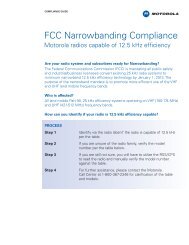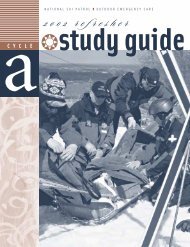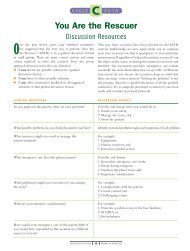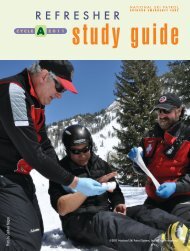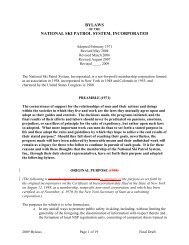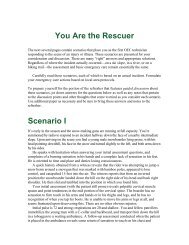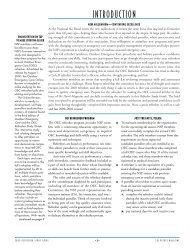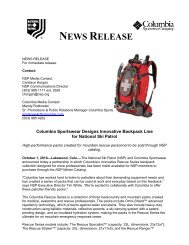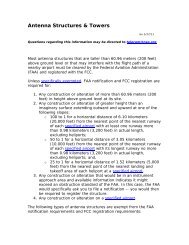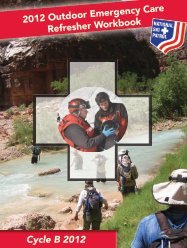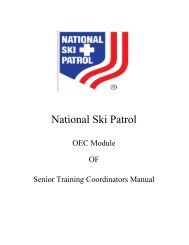Outdoor Emergency Care 5th Edition Orientation Exercise: OEC 5th ...
Outdoor Emergency Care 5th Edition Orientation Exercise: OEC 5th ...
Outdoor Emergency Care 5th Edition Orientation Exercise: OEC 5th ...
Create successful ePaper yourself
Turn your PDF publications into a flip-book with our unique Google optimized e-Paper software.
<strong>Outdoor</strong> <strong>Emergency</strong> <strong>Care</strong> 5 th <strong>Edition</strong><br />
<strong>Orientation</strong> <strong>Exercise</strong>: <strong>OEC</strong> <strong>5th</strong> edition for Cycle A<br />
This <strong>Orientation</strong> <strong>Exercise</strong> is a suggested study guide to be used to prepare for the 2011 Cycle A<br />
refresher. The 32 questions which are presented cover new material found in the <strong>OEC</strong> 5 th <strong>Edition</strong> for the<br />
Cycle A refresher. These questions may be reviewed at your local refresher or used by you for your own<br />
personal study guide. The questions come from the Stop, Think and Understand sections of the <strong>OEC</strong> 5 th<br />
<strong>Edition</strong> and other chapter questions. The <strong>OEC</strong> Refresher Committee intends for these questions to be a<br />
useful study tool to help you familiarize yourself with new information contained in NSP new <strong>OEC</strong><br />
5 th <strong>Edition</strong>.
<strong>OEC</strong> 5E <strong>Orientation</strong> <strong>Exercise</strong><br />
Name_____________________________<br />
Chapter 7<br />
Patient Assessment<br />
STU<br />
1. Which of the following statements regarding the primary assessment is not true?____________<br />
a. Its purpose is to quickly identify and correct any potential life threatening problems that may be present.<br />
b. It is conducted only on trauma patients.<br />
c. It should take 30–60 seconds to complete.<br />
d. Patient assessment and patient management often occur simultaneously.<br />
2. The ABCDs of primary assessment stand for____________<br />
a. airway, breathing, circulation, disability.<br />
b. airway, bleeding, circulation, disability.<br />
c. airway, breathing, circulation, deformity.<br />
d. auscultation, blood pressure, correction, discovery.<br />
3. “AAO _ 4” means____________<br />
a. awake, alert and oriented, checked four times at 5-minute intervals.<br />
b. awake, alert, and oriented to person, place, time and situation.<br />
c. awake, alert, and oriented to person, place, and time.<br />
d. awake, alert, and oral answers are correct.<br />
4. The three components of the Glasgow Coma Scale are____________<br />
a. best eye, verbal, and motor responses.<br />
b. assessment of pulse, respiration, and motor skills.<br />
c. assessment of pulse, respiration, and mentation.<br />
d. best response to grimace, circulation, and sensation.<br />
Chapter Questions<br />
5. The assessment referred to as tandem gait checks for____________<br />
a. a subtle injury or neurological deficit<br />
b. whether or not the patient’s arms move equally<br />
c. whether or not the patient’s pupils react equally.<br />
d. whether grip strength is equal in both hands.
6. Orthostatic hypotension is defined as____________<br />
a. a condition in which a patient has an abnormally low blood pressure.<br />
b. a condition in which a patient’s blood pressure increases when the patient stands up.<br />
c. a condition in which a patient’s blood pressure decreases suddenly when the patient stands up.<br />
d. a condition in which blood pressure is controlled by taking antihypertension medication.<br />
Review the following Skill Guides:<br />
Patient Assessment<br />
I have reviewed this Skill Guide______<br />
Patient Assessment—Trauma Patient<br />
Patient Assessment—Medical Patient<br />
I have reviewed this Skill Guide______<br />
I have reviewed this Skill Guide______<br />
Chapter 9<br />
Airway Management<br />
STU<br />
7. The mnemonic SLIC stands for ____________<br />
a. size, length, intubate, compress.<br />
b. suction, lubrication, insertion, compression.<br />
c. suction, lubrication, insertion, control.<br />
d. size, lubricate, insert, check.<br />
8. Pulse oximetry provides rescuers with what data? ____________<br />
a. Hematocrit level<br />
b. Patient’s respiratory rate<br />
c. Absolute data to determine whether or not oxygen administration is needed<br />
d. Quantitative data regarding the effectiveness of a patient’s ventilatory efforts<br />
Review <strong>OEC</strong> Skill 9-2 Inserting a Nasopharyngeal Airway<br />
Review <strong>OEC</strong> Skill 9-3 Inserting an Oropharyngeal Airway<br />
I have reviewed this skill____<br />
I have reviewed this skill____<br />
Chapter 10<br />
Shock Management<br />
STU
9. Stroke volume is defined as____________<br />
a. the amount of blood pumped by the heart with each contraction.<br />
b. the amount of residual blood remaining in the heart after a contraction.<br />
c. the amount of blood pumped in one minute.<br />
d. the amount of blood that completely fills the arteries at any given time.<br />
Matching<br />
10. For each of the following descriptions, indicate the type of shock that applies.<br />
____________ 1. Obstructive shock<br />
____________ 2. Distributive shock<br />
____________ 3. Hypovolemic shock<br />
____________ 4. Cardiogenic shock<br />
a. Occurs when blood moving from the heart to the arterial circulation is blocked<br />
b. Results from a critical drop in circulating blood volume<br />
c. Occurs when blood vessels lose their ability to constrict properly<br />
d. Is often caused by a severe allergic reaction<br />
e. Is caused by a loss of body water through vomiting or diarrhea<br />
f. Is caused by heart failure<br />
g. Is also known as “hemorrhagic” shock<br />
h. Can be caused by latex, bee stings, or peanuts<br />
i. Is caused by blood pooling in the pericardium<br />
j. Has a slow onset and is associated with severe head or spinal trauma<br />
k. Includes septic, anaphylactic, and neurogenic shock<br />
l. Can be caused by tension pneumothorax<br />
11. This type of prescription (RX) can exacerbate shock by limiting or preventing the clotting of blood.<br />
____________<br />
a. A narcotic
. A beta blocker<br />
c. An anticoagulant<br />
d. An analgesic<br />
Section 4 – Medical Emergencies<br />
Chapter 11<br />
Altered Mental Status<br />
STU<br />
12. Match each of the following terms with its definition.<br />
__________ 1. Alcohol<br />
__________ 2. Insulin<br />
__________ 3. Tumor<br />
__________ 4. Aura<br />
__________ 5. Polydypsia<br />
__________ 6. Acidosis<br />
__________ 7. Polyuria<br />
a. An abnormal growth of cells that may be benign or malignant<br />
b. A chemical that depresses CNS function<br />
c. A decline in body pH below normal<br />
d. A pancreatic hormone that regulates blood sugar levels<br />
e. A subjective sensation that precedes a seizure<br />
f. Excessive excretion of urine<br />
g. Excessive thirst and fluid intake<br />
13. For each of the following signs or symptoms, indicate whether the<br />
CNS malfunction is global (G) or focalized (F).
____________ a. Decreased level of responsiveness<br />
____________ b. Delirium<br />
____________ c. Motor weakness<br />
____________ d. Hallucination<br />
____________ e. Balance problems<br />
____________ f. Vision loss<br />
____________ g. Speech abnormalities<br />
____________ h. Combativeness<br />
____________ i. Delusions<br />
14. Indicate for each of the following characteristic of diabetes whether it refers to Type 1, to Type 2, or to both.<br />
____________ a. Insulin dependent<br />
____________ b. Non-insulin dependent,<br />
____________ c. 90-95 percent of all diabetes cases<br />
____________ d. 5–10 percent of all diabetes cases<br />
____________ e. Cells exhibit resistance to insulin, which prevents glucose from entering cells<br />
____________ f. Autoimmune disorder in which insulin producing cells are destroyed<br />
____________ g. Associated with obesity<br />
____________ h. Not related to obesity<br />
____________ i. Associated more commonly with younger patients<br />
____________ j. Associated more commonly with olderpatients<br />
Chapter 15<br />
Cardiovascular Emergencies<br />
Short Answer----STU
15. The five links of the American Heart Association’s chain of survival are:<br />
Section 5 – Trauma<br />
Chapter 17<br />
Principles of Trauma<br />
STU<br />
16. Match each of the levels of trauma center with the following descriptions. (some descriptions may have more<br />
than one answer.<br />
__________ 1. Level I trauma center<br />
__________ 2. Level II trauma center<br />
__________ 3. Level III trauma center<br />
__________ 4. Level IV trauma center<br />
__________ 5. Level V trauma center<br />
a. is typically located in sparsely populated regions<br />
b. is the highest designation of trauma center<br />
c. has a designated trauma surgeon available at all times, but does not have every subspecialist available<br />
d. has the same requirements as a Level I center but is not required to conduct research<br />
e. is typically located in densely populated areas<br />
Chapter Questions<br />
17. Which one of the following phases is not one of the three phases of injury?____________<br />
a. The post-traumatic phase<br />
b. The post-injury phase<br />
c. The pre-injury phase<br />
d. The injury phase<br />
Chapter 19<br />
Burns
STU<br />
18. What does TBSA stand for?____________<br />
a. Total body surface area<br />
b. Total burn surface area<br />
c. Total body surrounding area<br />
d. Total burn surrounding area<br />
Short Answer<br />
19. List four signs and symptoms associated with an inhalation injury. ____________, ____________,<br />
____________, and ____________<br />
Chapter 20<br />
Musculoskeletal Injuries<br />
STU<br />
20. The zone of injury is ____________<br />
a. the geographical location where an accident occurred and 10 feet circumference.<br />
b. the pinpointed location of a bone fracture.<br />
c. the area the patient identifies as being painful.<br />
d. the soft tissue, nerves, and blood vessels adjacent to a bone or joint injury.<br />
21. A nightstick fracture is best described as a ____________<br />
a. fracture of the humerus caused by falling onto the shoulder.<br />
b. fracture of the ulna caused by a direct blow from a hard object.<br />
c. radial-ulnar fracture caused by falling onto an outstretched hand.<br />
d. rare wrist fracture caused by falling onto the top of the hand.<br />
22. To <strong>OEC</strong> Technicians, a “mouse trap” is____________** definition of “mouse trap” is not found in the <strong>OEC</strong> 5 th<br />
a. an item used to catch rodents.<br />
b. a common snowboard injury.<br />
c. an uncommon digital injury.<br />
d. a rare type of finger injury.
23. CMS stands for ____________<br />
a. circulation, mechanism, shock.<br />
b. crepitus, motion, splint.<br />
c. circulation, movement, sensation.<br />
d. correction, manipulation, straighten.<br />
STU<br />
24. To <strong>OEC</strong> Technicians, “rolling a joint” refers to ____________<br />
a. an activity with an illegal substance.<br />
b. testing the range of motion of a joint.<br />
c. dislocating the knee or another hinge joint.<br />
d. inverting or everting an ankle.<br />
26. Which of the following statements about transferring a patient from a Quick Splint to a cardboard splint is<br />
true?____________<br />
a. It is generally safe to do as long as the fracture is stable, there are not multiple injuries, the fracture is closed,<br />
and there is no evidence of hypovolemic shock.<br />
b. Switching from a Quick Splint to a cardboard splint is advisable because the cardboard splint need not be<br />
remove to X-ray the limb.<br />
c. Once a Quick Splint is in place, it is inadvisable to replace it with a cardboard splint because doing so can<br />
exacerbate the injury.<br />
d. Contrary to popular belief, cardboard splints generally do not provide adequate support and should not be<br />
used.<br />
Chapter Questions<br />
26. Which of the following injuries should an <strong>OEC</strong> Technician attempt to reduce? ____________<br />
a. An anterior shoulder dislocation on a patient whose shoulder “pops out” frequently.
. An anterior sternoclavicular dislocation with intact CMS.<br />
c. A posterior sternoclavicular dislocation with accompanying vascular or respiratory compromise.<br />
d. None of the above because it is not within the scope of practice for an <strong>OEC</strong> Technician to reduce dislocations.<br />
Review <strong>OEC</strong> Skill 20-2 Creating and Applying a Figure Eight Splint<br />
I have reviewed this skill ____<br />
Review <strong>OEC</strong> Skill 20-3 Reducing a Posterior Sternoclavicular S/C location<br />
I have reviewed this skill ____<br />
Review <strong>OEC</strong> Skill 20-12 Replacing a Quick Splint with a Cardboard Splint<br />
I have reviewed this skill ____<br />
Chapter 31<br />
Geriatrics<br />
STU<br />
27. Which of the following changes are typical for seniors? (choose all that apply)<br />
__ a. The brain and peripheral nervous system are less effective at processing and transmitting data and<br />
impulses<br />
__ b. The total number of brain cells decreases<br />
__ c. Brain weight decreases by as much as 10 percent<br />
__ d. CO2 levels in the blood increase<br />
__ e. Blood oxygen levels permanently decrease<br />
__ f. Cerebral blood flow decreases<br />
__ g. Sensitivity to stimuli such as light, sound, and pain increase
28. A very slight change in mental acuity between the primary assessment and the secondary assessment of an<br />
elderly trauma patient is likely indicative of____________<br />
a. fatigue; older people tire more easily than younger people.<br />
b. a normal age-appropriate behavior; older patients normally have a somewhat diminished level of mental<br />
acuity.<br />
c. a possible neurologic deficit caused by the trauma.<br />
d. a sign of developing dementia.<br />
STU<br />
29. “Tenting” of the skin could be indicative of____________<br />
a. dehydration or hypovolemia.<br />
b. tissue breakdown due to an age-related decrease in skin elasticity.<br />
c. extreme or rapid weight loss.<br />
d. hypothermia or hyperthermia.<br />
30. Which of the following statements about backboarding an elderly patient is correct? ____________<br />
a. Backboard elderly patients just as you would younger adult patients.<br />
b. It is necessary to tighten the straps more securely in an elderly patient.<br />
c. Because hip fractures occur easily in elderly patients, cross the straps loosely over the lower abdomen instead<br />
of the usual placement over the bony pelvis.<br />
d. Use towels, jackets, and other padding material to fill any voids, and pad all bony prominences.<br />
Chapter Questions<br />
31. Match each of the following conditions to its description.<br />
a. A decrease in bone density due to mineral loss<br />
b. “Humpback” curvature of the upper thoracic spine<br />
c. “Swayback” appearance due to inward curvature of the lumbar spine<br />
d. A lateral curvature of the spine<br />
__________ 1. kyphosis
__________ 2. lordosis<br />
__________ 3. osteoporosis<br />
__________ 4. Scoliosis<br />
32. Match each of the following medication types to its action.<br />
__________ 1. beta-blockers<br />
__________ 2. calcium-channel blockers<br />
__________ 3. diuretics<br />
__________ 4. blood thinners<br />
a. Make the heart contract more efficiently, manage cardiac arrhythmias, and lower blood pressure<br />
b. Help decrease the volume of circulating fluid within the cardiovascular system<br />
c. Reduce heart rate, blood pressure, and heart contractility<br />
d. Are typically prescribed to patients with a history of mechanical heart valve replacement, irregular heartbeat,<br />
deep vein thrombosis, or pulmonary embolism



